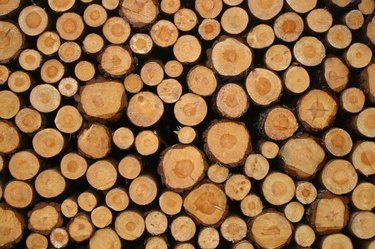
Burning logs for warmth during the colder months is still a viable home heating option for many households. However, chopping wood into reasonably sized logs takes a lot of strength and time. Electric log splitters provide a fast mechanism for cutting wood, especially if the homeowner requires large timber volumes for future wood-burning use. Although the splitter is electrically driven, the cutting mechanism requires oil for pressurizing the splitter's hydraulics.
Electric Log Splitter Function
Video of the Day
An electric log splitter resembles a common sawhorse. A pushing mechanism resides on the splitter's left side. Across the splitter's length is a splitting wedge, mimicking a triangle. A user places a log along the splitter's length. The pusher presses against the log's end, compressing it against the splitting wedge's triangular point. This wedge cuts into the log and splits it into two pieces.
Video of the Day
Oil Type
Electric log splitters require hydraulic oil with a 10W (Winter) weight rating. This hydraulic oil type provides lubrication for gears and other mechanical parts during extreme cold and heat, effectively protecting parts from wearing down. In addition, the electric log splitter uses this hydraulic oil for pressurizing the hydraulic system. As a user activates the electrical motor, the hydraulic system builds pressure with the hydraulic oil. Once pressurized, the hydraulic system initiates the pusher's motion for cutting the log.
Bleeding
Electric log splitters have a bleed screw assembly. A user must open the bleed screw before operating the splitter. The bleed screw allows air to escape out of the hydraulic system. Air that remains trapped within the system can damage the splitter. The enclosed space, housing the trapped air and hydraulic oil, will become overly pressurized, possibly damaging the hydraulic components. However, the bleed screw should remain tightened during storage or moving the splitter to a different area.
Oil Replacement
Hydraulic oil requires replacement after 150 hours of use. Over time, the oil can produce sediment within the hydraulic system. This sediment eventually settles on the hydraulic components, possibly damaging them with deposit layers. Periodic oil replacement keeps the internal parts bathed in pure oil, prolonging the splitter's lifespan.
Troubleshooting
Low amounts of hydraulic oil within the splitter's assembly will affect overall functioning. A humming electrical motor with no pusher movement usually signifies that the hydraulic oil level is low. The hydraulic system cannot attain the needed pressure for moving the pusher against the log. Verify the hydraulic oil's level by checking the dipstick. There should be measured graduations on the dipstick indicating a maximum and minimum oil level.